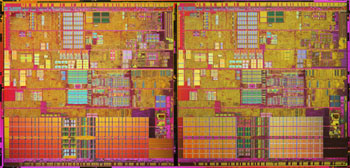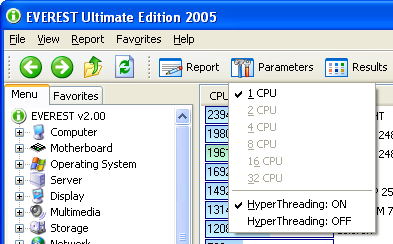Benchmark pages of Lavalys EVEREST Ultimate Edition provides several methods to measure system performance. These benchmarks are synthetic, ie. the results show only the theoretical (maximum) performance of the system. In contrast to application tests, synthetic benchmarks do not tend to reflect the "real world" performance of the computer. These benchmarks provide quick and easy comparison between computer states, e.g. when certain parameters (CPU clock speed, memory timings, etc) change in system configuration.

CPU and FPU benchmarks of EVEREST Ultimate Edition are built on the multi-threaded Lavalys benchmark engine, that supports up to 32 simultaneous processing threads. The attained results are scalable either in multi-processor (SMP), multi-core (CMP) and HyperThreading enabled systems. In other words, EVEREST can utilize the full potential of the current and also the next generation of CPU technologies, such as the dual-core AMD Athlon 64 X2, AMD Opteron and Intel Pentium D processors.
Intel HyperThreading support
Intel's HyperThreading feature shows moderated performance improvement in EVEREST benchmarks, because in HyperThreading enabled processors most internal resources (buffers, registers, caches) are shared between the two logical processor units. More specifically the Nortwood, Gallatin and Prestonia core based Intel NetBurst architecture processors do not contain sufficient internal resources for the extremely optimized benchmark routines EVEREST uses, so on these processors the default HyperThreading setting is disabled, in order to avoid "bottleneck" situations and attain better benchmark results. The Prescott, Nocona, Irwindale and Potomac based Intel processors have way more internal resources than their predecessors, so on these cores HyperThreading is enabled by default.
Enhanced Halt State and Enhanced SpeedStep support
In order to provide appropriate benchmark results, EVEREST disables the Enhanced Halt State (C1E) and Enhanced SpeedStep (EIST) feature of Intel desktop processors during all benchmark measurement processes. Such features are available in the latest Pentium 4, Pentium D and Pentium Extreme Edition processors. They are implemented to lower power consumption and heat production by lowering CPU clock frequency and CPU core voltage when the CPU is idle.
System requirements
EVEREST Ultimate Edition benchmarks have considerably higher system requirements than the main EVEREST application does. To get meaningful and comparable benchmark scores, at least an Intel Pentium class processor (implementing the Time Stamp Counter feature) and 128 MB system memory is required.
64-bit Windows systems are supported, however the benchmark tests currently use 32-bit code only, and so they are unable to utilize the 64-bit processing capabilities of such systems.
Before starting the benchmarks
In order to attain the highest possible benchmark scores make sure to close all background applications, including ICQ, MSN Messenger, Winamp, web browsers, email clients, hardware monitoring tools, etc. The least number of applications running in the background, the higher benchmark scores can be reached. For comparative benchmarks (ie. when comparing systems based on benchmark scores), make sure to perform benchmarking in a clean Windows installation.
Starting the benchmarks
Benchmarks are not started automatically, because it's possible to configure them before starting the actual performance measurement process. On CPU and FPU benchmark pages a new button appears on the tool bar named Parameters.

By clicking on the Parameters button, a dropdown menu appears to configure the number of processors to be utilizied by the benchmark method.

And it's also possible to configure whether the benchmark should use Intel HyperThreading technology. For more details please refer to the Intel HyperThreading support topic above on this page.
Comparing results
Lavalys constantly improve the benchmarks of EVEREST, hence comparing benchmark results of different EVEREST versions is absolutely not recommended. For example, attaining a result of 200 scores in EVEREST Version 2.50 cannot be directly compared to a result of 200 scores measured using EVEREST Version 2.80.
Understanding the results
Except for the Memory Latency test, the higher score means the better performance.
Measurement unit of the results is MB (megabytes) per sec for Memory Read and Memory Write tests; ns (nanosecond) for Memory Latency test; and KB (kilobytes) per sec for CPU ZLib test.